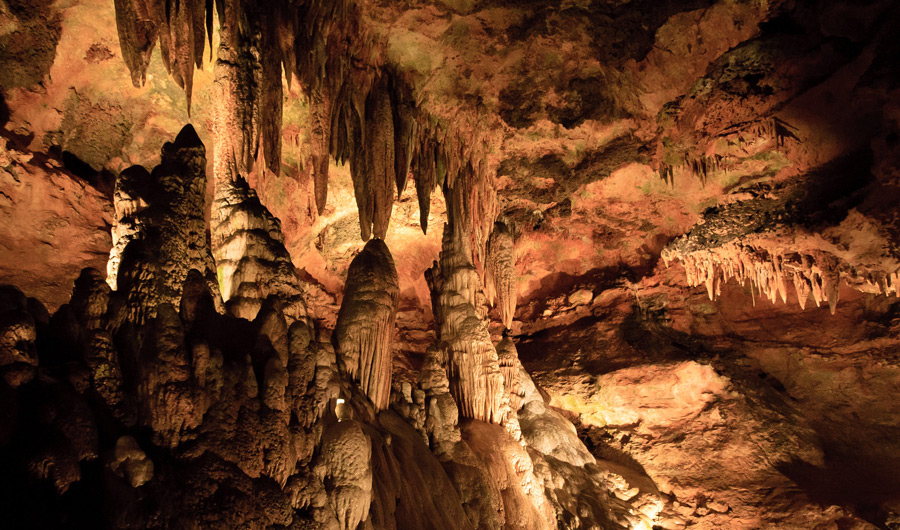Stalagmite Chronicles Climate Whiplash in California's Past

New research finds that minerals in stalactites and stalagmites can record important information about past rainfall in an area. (The cave shown here is in Luray, Virginia.)
(Inside Science) -- If you've ever gone spelunking in a cave, you may have ducked to avoid a low-hanging stalactite or stepped warily around a jutting stalagmite. But what you may not have realized is that these subterranean protrusions, known collectively as speleothems, hold precious information about past climates. Now, scientists have taken a close look at a California speleothem and discovered evidence that 8,200 years ago, during a sudden global cold snap, the region experienced what researchers are calling "climate whiplash."
The aptly named "8.2-kiloyear event," which lasted about 160 years, is believed to have been triggered by the collapse of a large ice sheet that covered much of North America. This collapse spilled enormous volumes of freshwater into the Atlantic Ocean that disrupted ocean currents responsible for transporting heat around the globe. Much of what scientists know about this climate anomaly comes from ice cores and sediments from Greenland. To gather clues about important weather patterns, such as rainfall, in other regions, researchers study climate records like tree rings, lake sediments and speleothems. But until now, few such studies have been able to describe regional rainfall patterns in a quantitative way.
"Often, all we can say is that a period was wetter or drier. We can't really put numbers on it," said Kathleen Johnson, a paleoclimatologist from the University of California, Irvine. The numbers would help scientists better understand how climatic shifts, such as temperature changes or disrupted ocean currents, affected rainfall patterns in the past. Such insight could help improve predictions about the likely impacts of human-caused climate change in the future. "[Rainfall] is one of the things associated with climate change that is most likely to have the biggest impacts on humans and on our infrastructure. So, it's a priority to improve reconstructions of past rainfall changes," said Johnson.
Now, a team of researchers led by Cameron de Wet, a paleoclimatologist from Vanderbilt University, has aided that effort by using a stalagmite from central California's White Moon Cave to construct a quantitative record of rainfall along California's coast. The findings, published in February in the journal Geophysical Research Letters, reveal that during and just prior to the 8.2-kiloyear event, California experienced alternating periods of intense drought and heavy rainfall, and that these fluctuations may have been more extreme than the wet and dry swings of recent decades.
"[It] was really exciting to see what happened during this climate event with rainfall, in a pretty precipitation-sensitive place," said Jessica Oster, a paleoclimatologist from Vanderbilt University and co-author on the study.
The work demanded the researchers do a bit of spelunking themselves. "We wanted to get some data from deep down in the cave and getting to those sections entailed what cavers call an ear dip," said de Wet. "You crawl through a tight little passageway, and it's very muddy. There'll be water that you have to dip half of your head into. It's a wild cave."
Speleothems are some of the best climate records we have for areas of the globe outside the polar regions, said Johnson, who was not involved in the study but is writing a commentary for the journal. These structures grow over hundreds and thousands of years, as waters from the surface carry minerals down into underground caves where they are deposited onto cave ceilings and floors.
Much of the usefulness of speleothems comes from the fact that they can be dated very precisely said Jens Fohlmeister, a paleoclimatologist from the Potsdam Institute for Climate Impact Research in Germany, who was not involved in the study. This dating allows scientists to analyze speleothems for chemical signatures of past climate conditions and then tie them to specific time periods.
De Wet and his team took a close look at the different forms of calcium in the stalagmite.
They knew the lighter forms of calcium are more likely to get trapped in minerals before reaching the cave. But heavier rainfall flushes greater amounts of this light calcium into the cave, where it accumulates in stalagmites. By analyzing how much light and heavy calcium occurred in different layers in the stalagmite, and by dating these layers, the researchers could estimate how much rain fell on the surface world at different times.
According to Fohlmeister and Johnson, analyzing the calcium composition in this way is a relatively new method, applied only a handful of times around the world and never before in California.
In all, de Wet's team was able to show that during and just before the 8.2-kiloyear event, California was struck by alternating periods of severe drought and heavy rainfall. Moreover, the findings reveal "California experienced dramatic rainfall variability in the past that meets or exceeds what we've seen in recent decades," said Johnson. "It's a call to arms. Making sure our water infrastructure is capable of withstanding those dramatic swings is really important."
The findings offer scientists important information that could help improve climate models, said Fohlmeister. If a climate model can simulate past changes in rainfall, such as those described by this study, it might predict future changes just as well.
Although the study focused on California, analyzing the calcium compositions in stalagmites from other regions could help researchers refine the rainfall records of those places too. "It could be used in stalagmites around the world," said Fohlmeister.
Johnson is interested in using the method to reconstruct the rainfall history of Asian regions. "The Asian monsoon system affects over half the world's population and is projected to undergo dramatic changes in precipitation. But [global] climate models are challenged with predicting regional precipitation changes," she said. "So, the more information we have, the better."
